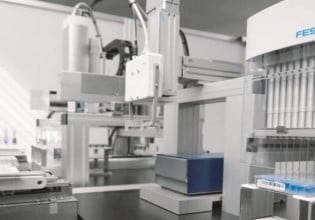The Three Levels of a Factory Network
What makes a factory network? There are three levels: device, control, and enterprise. What does each level consist of, and how is it used in a factory network?
In the past two decades, communications networks, in general, have become more complex. Not only are they increasing in the number of components and volume of data handled, but also the levels of connectivity demanded, which can further complicate network layouts. This is also the case with factory networks. But, to better streamline factory network architectures, a three-layer (or three-level) model was introduced and standardized in the industry.

Figure 1. The three-layer factory network model pyramid. Image used courtesy of Analog Devices
The three levels of a factory network are:
- Device level
- Control level
- Enterprise level
This model can be seen as a pyramid. The device level is at the bottom of the pyramid, containing field devices, sensors, actuators, and all other floor-level components. The control level is next; this level includes robots, PLCs, HMIs, and SCADA. Last, at the top of the pyramid sits the enterprise level, comprised of the higher-level software applications that plan and strategize tasks for the components of the other two layers. More details about the components and functions of each level will be discussed in the next sections.
Device Level
The device level consists of all the Fieldbus, devices, sensors, and actuators in an automated system. These components are in direct relation with the factory’s production process by either capturing elemental data about it or executing singular tasks to effectuate the process.
From a networking perspective, there are three types of networks within the device level based on the size and characteristics of the data transferred in each one.
Sensor Bus
These are the least complex networks, where data is mostly transferred in bits. In these networks, a single network cable can connect multiple field devices, such as limit switches and optical sensors. The sensor bus network can also transmit output signals through the same cable to indicator lamps, alarms, or other actuator devices. Some well-known bus networks are ASi and Seriplex.

Figure 2. The ASi network is an example of a device-level network. Image used courtesy of Bihl+Wiedemann
Device Bus
The device bus has a similar function to the sensor bus network, but it works on a larger scale by connecting multiple sensors and actuators together. This network also connects equipment such as variable speed and frequency drives, and motor control centers. DeviceNet, Profibus-DP, and Intebus are some examples of device buses. Data packet size is in the bytes range.
Fieldbus Networks
Fieldbus is a group of protocols that enable connecting multiple devices to a single industrial network, allowing for real-time control and monitoring. Some examples of Fieldbus networks are Modbus, ControlNET, and EtherCAT.
Control Level
Control level networks are the realm of programmable logic controllers (PLCs), human-machine interfaces (HMIs), supervisory control and data acquisition systems (SCADA) user interfaces, and other advanced devices, such as vision systems, industrial robots, and motion controllers. These networks are the most advanced networks on the factory floor, where data communication happens at a fast speed.
The main types of information flowing at this level are source code, programs, parameters, and data from advanced devices. Typically, PLCs connected to device-level elements are also connected to each other, as well as to HMIs. The HMIs enable the configuration, control, and manual operations of the instruments in the network.

Figure 3. Diagram of a ControlNet control network. Image used courtesy of Rockwell Automation [PDF]
There are also many smart instruments, such as cameras and advanced vision systems, capable of complex operations that can be connected to the control level network. The size of data handled by these devices would be too complex for the device level. Vision systems normally share large amounts of data resulting from image capture evaluations.
SCADA system user interfaces are also at this level. A SCADA consists of many device-level components connected to a central user interface, which is the SCADA HMI.
Enterprise Level
The enterprise level is also referred to as the information level. At the top of the pyramid, it is the most overarching network level that manages the automation system strategically, as well as connects computers and departments of a company together. In addition to managing the automation and production process, the enterprise network interconnects production planning, quality management, market analysis, supply chain, orders, shipments, and other processes of a company.

Figure 4. Enterprise level and control level networks are directly connected. Image used courtesy of Automation Direct
Many systems incorporate software platforms at this level, such as enterprise resource planning (ERP), which helps further integrate and automate the processes. In highly automated systems, there are other software applications that are above the control level and communicate directly with ERPs. For example, warehouse management systems (WMS) and management execution system (MES) applications are responsible for the strategic and efficient automation of production and logistics tasks.
Information exchange happens on a large scale, and it is mainly computer-driven, allowing for the collection and monitoring of data, as well as other tasks such as file transfers and email exchange.
Within a factory network, all levels play important roles. In short, the device level collects data, the control level controls parameters, and the enterprise level runs logistics. Without one of these levels, the others would crumble. It is important to think of these levels as a network that works together rather than individual elements in a control system.






